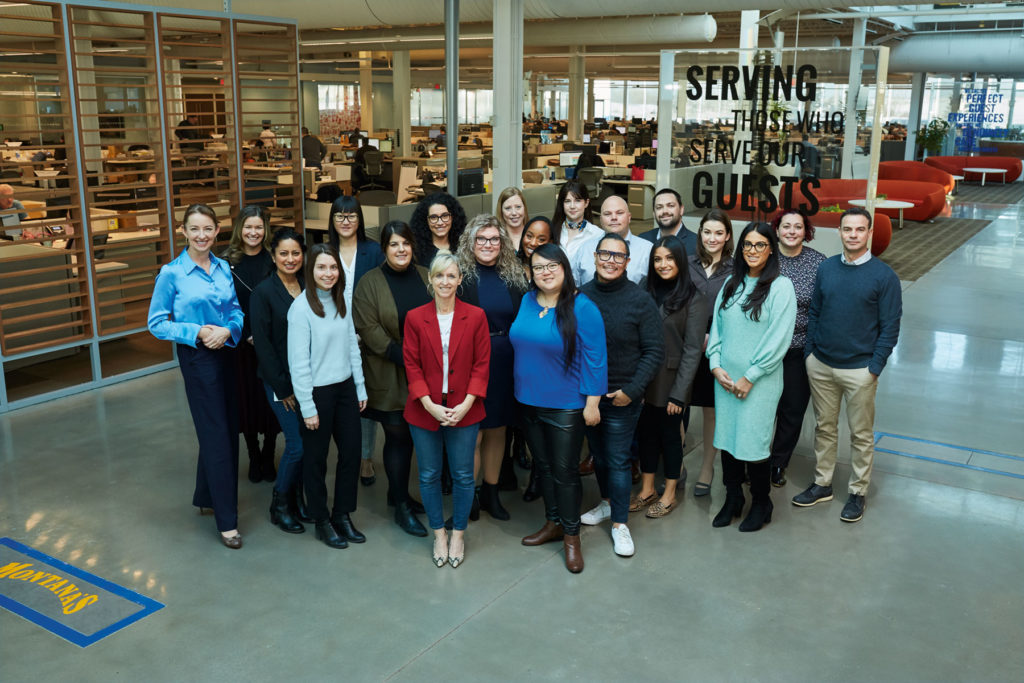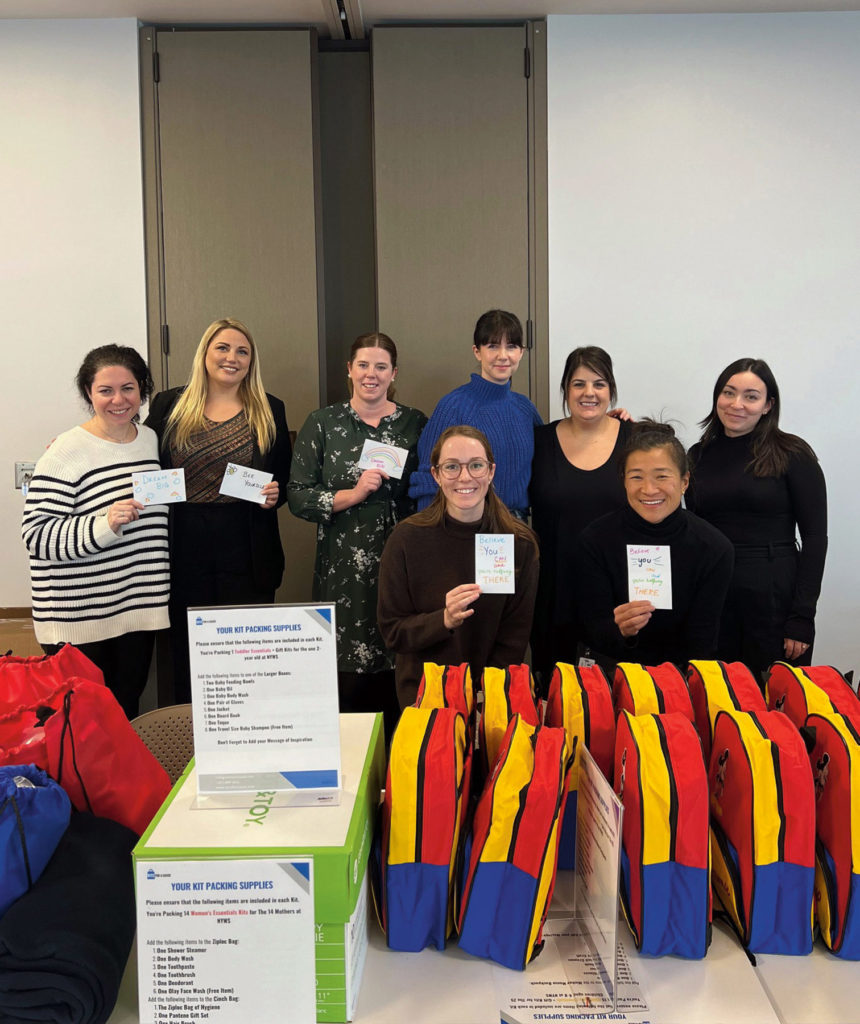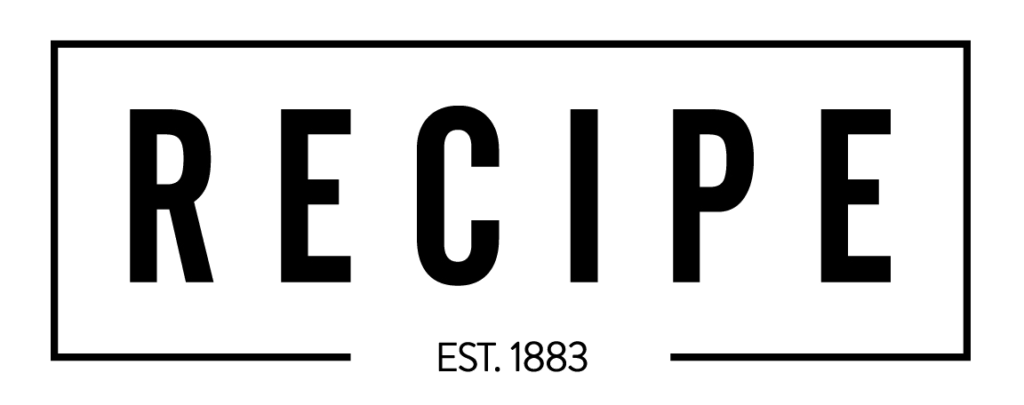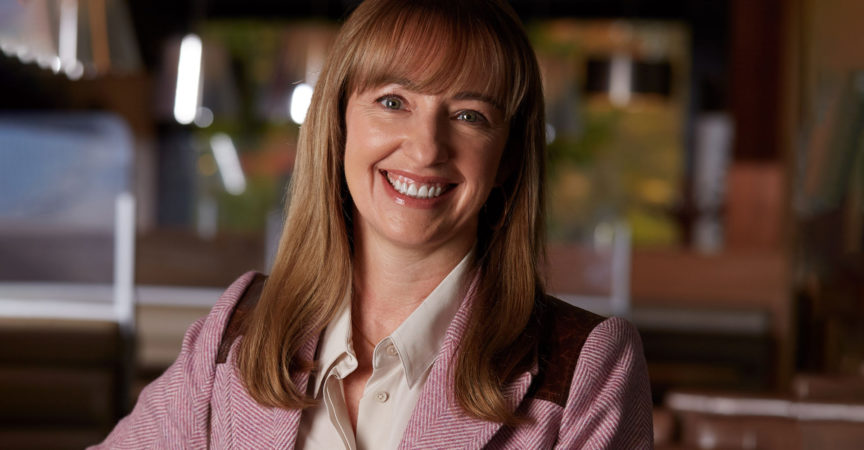In Conversation with Julie Denton, Chief People Officer, Recipe Unlimited Corporation & Restaurants Canada Board Member
RECIPE UNLIMITED CORP. has over 1,200 corporate, franchise and joint venture operations across five countries and has been a major force in Canadian foodservice for almost 140 years. Their brand portfolio includes Swiss Chalet, Harvey’s, New York Fries, The Keg, Montana’s BBQ & Bar, Kelseys, The Pickle Barrel, The Burger’s Priest and many, many more. You don’t realize that much scale and influence without incubating a profit-minded culture; however, Recipe has taken a bold, new approach to managing the quality and profitability of their brands. They have fully integrated their corporate and social strategies, placing their bets on people, planet and food, and it’s paying off.
Julie Denton is one of the central architects of the plans and policies elevating the influence and opportunity spectrum for Recipe employees. Her business-minded approach is enriched by her rich, multi-sector consulting and industry experiences in fintech, the public sector and global mining. She brings strong bottom-line strategy and systems-thinking housed in her belief in people, the hospitality industry and doing the right thing.
We met with Julie to learn more about Recipe’s journey so far, and to collect and share some of the key learnings, insights and ideas that can help Canadian operators turn today’s challenges into future opportunities.
MM: You joined Recipe Unlimited, your first leadership role in the hospitality industry, in January 2019. What experiences helped prepare you for the role and what were your initial thoughts on the jobs to be done?
One of the benefits of having been in different industries is that you get to bring in tidbits from sectors that have evolved differently and are a little bit further down the path. My experience coming into the restaurant sector was that, for such a people oriented business, we actually didn’t have great people practices. This business is all about hospitality, and all about people—that energy and passion that hospitality people bring. And yet, I don’t think we were at the front end of people processes and practices.
Viewing the industry through a talent lens, and particularly through diversity, equity and inclusion, has been important for me. Our industry is a significant employer of women and new Canadians, so the fact that we weren’t more intentional around our DE&I efforts was perhaps a little bit surprising.
MM: How have those initial observations informed your talent, talent management and career progression strategies at Recipe?
We are big. One of the benefits of Recipe is that you can start as a garnishee at Harvey’s and you become a training manager at one of our full-service brands with a phenomenal career progression. Mobility and movement are particularly important for us, but first, we had to put the systems in place to identify, grow, develop and nurture talent, and pull people up through the system.
If I think about my own lens and my own career, I’ve spent a lot of time on organizational effectiveness, talent management and talent practices. Bringing those learnings into this sector and applying them—whether it was paternity leave or maternity leave or other core policies and practices that we didn’t have in place. For example, we needed virtual training and development programs that could accommodate people from all time zones all the way to mentorship programs to expose teammates to other colleagues with different work experiences they could learn from.
There were just so many good examples from other industries we just didn’t see in ours. I’ve got lots of colleagues at other competitive organizations where they’re doing great things, but at Recipe, we recognized we had a lot to do.
Viewing the industry through a talent lens and particularly through diversity, equity, and inclusion, has been important for me. Our industry is a significant employer of women and new Canadians. The fact that we weren’t more intentional around our DE&I efforts was perhaps a little bit surprising.
MM: Were you brought on to create and implement these strategies and programs at Recipe?
Yes. Our CEO, Frank Hennessey, is a people person with a clear vision. When he came back to the organization after having departed for a time, it looked a little different than when he left. He really felt that, as a hospitality organization, people needed to be more at the forefront than they were. When you have a CEO with a clear vision for that it makes the rest a lot easier. When I came in, my focus was on standing up what we call Recipe University, making sure we had a targeted training program and more engaging training tools in the field for restaurant team mates. We launched a number of programs and a gamification app to do training and we’ve got over 40,000 learners on that application now.
Multi-faceted training was a big part of our CEO’s vision; however, he wanted a business person to be accountable for people. I am a business person, not an HR person, and my team will be the first to tell you that. We’re focused on understanding and optimizing the ways we find and recognize great talent, deliver a positive employee onboarding experience and bring people up through the organization. We ask ourselves, “How do we offer something that’s compelling to people?”, “How do we recognize and reward them?”, “How do we make sure that they’ve got benefits that meet their needs and they feel good about?”. We introduced health and wellness benefits, which were particularly important during the pandemic, but it was developed more through a business-driven people lens than a traditional HR lens.
MM: Recipe publicly releases a very business-minded and transparent CSR report that sets out strategic business targets and defines success metrics while being surprisingly frank about identifying gaps, particularly around DE&I goals. What is the objective of the report and how is it developed?
One of the core values at Recipe is “Do the right thing.”, and we really believe that. Ironically, we launched our values in January of 2020 without knowing what was going to happen just six weeks later.
When we talk about our values of celebrating people, passion and curiosity, owning it and doing the right thing—all of those things are so instrumental to our CSR program. It’s thorough, data-backed and robust. We’ve got an incredibly talented business lead in our strategic sourcing team, Gina da Costa, who leads that along with support from myself and Peter Vale. We have cross-functional stewardship at the top, right up to our CEO and our executive steering committee. Our large brand leaders, our CEO, and CFO all participate at the governance level, from our chief development officers to our brand leads. Incredibly talented, passionate, curious individuals who want to do the right thing participate in our working team. Each functional group came with their ideas around what they wanted to do and what they thought we should achieve. We then put those ideas through a filter to figure out what we can get at and the effort and resourcing required to achieve it. We also hired an individual to project manage the process and really hold us accountable for what we said we’re going to do.
One of the core working philosophies from our CEO and our team was transparency. We met with our auditors, independent rating agencies and one of our bankers to ask what our investors and the public are looking for and what they expect. What are our peers and our competitors doing? Who is doing it well? We did a lot of due diligence up front to agree on the right metrics and methods to hold ourselves accountable.
We’ve got large suppliers like Sysco and Maple Leaf that are a little bit further down the journey, so we wanted to learn from them as well. It started with governance and making sure that, right from the top, we were all aligned on what we wanted to do. I think the core value, “Do the right thing.” really drove us, along with a commitment to transparency and data. It’s one thing to put out a marketing piece, and quite another to be able to defend the data integrity down to the individual store. We also met with our governance committee regularly. Our board care deeply. Now that we’ve gone private, our new board still wants CSR updates because it’s become part of our DNA now. Our working group meets weekly, so it’s not something that people are doing off the sides of their desks.

MM: What was the catalyst behind the organizational decision to prioritize the people strategy and undertake such a huge project? Was it driven by philosophy, economics or both?
At the time and still today, you couldn’t pick up a paper without reading about plastics, reading about Davos, reading about what was going on in the world. We started looking at the amount of plastic we were generating—whether that was plastic bags, lids or straws. Our view was that we just had to take a stance; we needed to draw a line do better, so we asked what we could do better—what was in our realm of influence?
We started with a press release that stated, “We’re eliminating plastic straws by this date.” We just drew a line in the sand and that forced a sense of urgency to fix it and do better. It started, and then it snowballed. Don’t get me wrong—it wasn’t easy. We had a packaging team and a strategic sourcing team working behind the scenes on SKU after SKU. We’ve now converted approximately 300 SKUs to more sustainable alternatives in order to achieve our sustainable packaging goals. The sheer magnitude, the vendor engagement and involvement needed to transition that many SKUs was staggering.
We’re also focusing on more sustainable sourcing efforts and commitments around seafood and beef and chicken, remain committed to supporting the humane treatment of animals. But it really started with plastic straws and that rippled into our strategic framework of People, Planet and Food.
MM: These are large-scale changes. What impact have they had on culture and operations? What’s the sense of the effect this work has had from the enterprise down to the store level?

Every function is probably impacted a little bit differently, and some of those are real tangible, positive benefits. When you talk about things like pay equity and things that touch people at their core, those are easier to explain. I think of employee resource groups for women and LGBTQ2S+, those are very much employee engagement tactics under our People pillar. These initiatives touch people at an emotional level. They’re felt, and we do hear that people really enjoy being part of them. Employees enjoy being able to have an influence on creating policies or events or new activities.
We also have to be aware of incremental costs. If you move away from a plastic lid, there may be incremental dollars, so transparency and getting people onside to do the right thing sometimes requires a little bit more conversation, support and influence. Franchisees have embraced the changes around water and energy because those are also cost-saving measures. Some of the things we’ve introduced are not only the right thing to do, but also have some immediate payback in a world where costs are increasing. If we can show them positive financial benefits at the same time as doing the right thing, that makes it a little bit easier to sell.
To engage frontline staff, our brands make our corporate strategy relatable to their individual brand teams. Harvey’s and New York Fries are great examples of that. They’ve driven their partnerships with Tree Canada right down to the store level, collaborating together to complete employee engagement activities such as tree planting across Canada. Plastic toys have been replaced with Harvey’s Grow a Plant compostable activity pots, so they’ve taken that right down to the front line. Harvey’s and New York Fries have also moved to paper packaging using certified sustainable sources. They are also using this as a catalyst for more conversation, resolving to do a better job with recycling. It started with moving the needle, being trusted to have a conversation, and grew to teammates wanting to share ideas to help us continue to do better.
Depending on the brand and depending on the stakeholder group, I would say they’ve embraced the changes differently. At the point of talent attraction, people connect with our values. The number of people who have read the CSR report is amazing. It’s really rewarding when that comes up in an interview and they say, “You know, I read that and I was really touched by that”. It is also great for us to see that we are engaging people who share a common set of values.
MM: You have rightly earned a lot of respect for your work on strategic People programs and initiatives alongside the executive team at Recipe. What has that journey looked like, and where would you like to go from here?
One of our brand standards is better awareness around diversity, equity and inclusion. We make training and educational content available to franchisees and their teams that we’ve seen them embrace. It’s something that cascades throughout the brand and all the teams. We did some mandatory training early in our DE&I journey for all general managers and franchisees, and every year we’ve added to the curriculum. Now, they have the option to self-select, but they choose to take it because they’ve found it really informative and engaging, and we’re using local, not-for-profit partners to do it. It’s a great way to engage not-for-profit associations and build relevant training material.
On the People side, we use education and offer training around unconscious bias for frontline managers and employees through our digital platform. We call it, “RU Game”, as in “Recipe University Game”, and we push out content around key topics and dates like Black History Month or Lunar New Year. It’s very DE&I-oriented and contains significant unconscious bias training for staff across our brands.
We’ve taken a holistic view of the business—through the lens of People, Planet and Food—and we’re very careful about pulling any one lever at any time. At no point do we want to impact franchisee profitability; full stop. That can’t happen for them. That can’t happen for any part of the company. So, we’re committed to doing good, and we achieve it by balancing our initiatives. We have a very talented strategic sourcing team, and we have the size to purchase at scale. All of this adds incremental value and provides great employee engagement opportunities. And ideally, if there’s great engagement and great training, there’s less turnover. We take a balanced view that extends value across the entire company.
MM: Recipe is a very large organization. Based on your experience and insights, are there any approaches and tactics you feel can help support any Canadian restaurant operation?
First, I think we really, really need to look at how we interact with our teammates and use a more teammate-friendly lens. It’s about how you make the right introduction to the right talent at the right time for the right role. We got caught up in a “warm body in a seat” mentality. It was, “We’ve got a vacancy—let’s go!”. If you hire incorrectly right at the start, that causes a world of issues in your restaurant—wrong personality, wrong fit, wrong skill set, wrong core value set—and that can be really toxic.
Investing in hiring the right teammate and in delivering the right teammate experience from attraction to hire and making sure you have a compelling total offering is critical. That offering has to include benefits, it has to include some flexibility, it has to include the ability to choose your schedule and choose your shifts so that it works for people. During the pandemic, many industries had the benefit of naturally accommodating flexibility and hybrid work. That doesn’t work as well in our industry, but there are tasks like scheduling and some of those back-of-house activities that do work in a hybrid world. Why can’t managers do that off site in the convenience of their home around different work hours and perform guest-facing activities during restaurant hours?
It’s about trying to think about how restaurant work could get done a little differently to accommodate a little bit more flex for this industry. That will help people stay. It’s always easier to keep than to find new, so the flexibility and choice around schedule and pay—how and when people get paid, the frequency and the method—are important. There are many different providers and options available now from electronic tipping on cards, weekly pay or other methods. We’ve introduced just-in-time pay so, as soon as someone has worked their shift, they can get paid for it. Having that optionality for teammates and thinking about how, at each touchpoint, we can make it better makes a difference.
In looking at career development, we need to understand employee aspirations, know what they want to learn, and how they can grow in the restaurant. Can they do rotations and try different roles? Can they get involved in local marketing initiatives in the community? We’ve got so many in-house photographers now right at our fingertips, if we think of them that way. They could be ambassadors. Recognize an employee for taking a great picture and repost it. That’s far more engaging than having an external company come out and take a picture of your food. We can leverage talent in more creative ways to let them grow and really do what they want to do.
MM: Of course, it’s difficult to measure success due to the volatility over the past few years, but what’s your sense how these efforts and initiatives are working so far?
We track turnover and retention across all categories of roles, and we’ve got very low turnover in our manager group. If you have active and engaged managers, that experience cascades down to frontline teammates. Of course, there are markets that are trickier than others, where we still have pressure when someone across the street is offering 50 cents more. I don’t know that we’re ever going to completely move away from the Almighty Dollar as a deciding factor. Our hope is that all of those other benefits are far more compelling—that the ability to choose your shifts or the ability to learn and develop through Recipe University training platforms provides real career growth, engagement and stickiness. We also did a lot of compensation benchmarking, increasing the salary bands for our roles and launched profit-sharing and other new programs to drive more personal accountability with personal metrics, not just financial. Especially during COVID, we wanted the stores to feel like those bonuses were achievable, because it wasn’t all financial.
We’ll have a better sense of how we’re doing in the next 60 days, when we can compare to last year at this time, when we were closed in many places across Ontario. We’re just starting to get to the point where we’ll finally have that 12 months of consistent information that feels a little bit more normal. That’s when we’ll really be able to start to prove out everything we’ve done.
The demographic mix of your team should be driven by the market in which you’re operating. It’s about making sure that your team reflects your local community and that success is backed by spectrum workplace policies and DE&I and unconscious bias training.
MM: From a 10,000-foot view, Recipe seems to have made big investments and some significant bets on the future. Do you feel all operators should be looking at finding ways to adopt similar future-proofing strategies and initiatives to avoid missing the moment?
Absolutely, and baby steps are better than no steps, right? Moving a number of things forward at the same time can be difficult, but you do need to do it with the end goal in mind: What kind of organization do you want to have? What is the employee experience you want to offer? I think operators really need to define that if they want employees that stay with them through thick and thin. Listening to what your employees want further improves your chances of keeping your core team together. Things like RSPs and longer-term retention strategies are great, but if you hire a lot of students, you might consider a monthly health and wellness benefit they can put toward their gym membership or running shoes. These tools align differently with different demographics, so having a clear understanding of your desired mix of teammates and lining up your programs against that makes sure the investment resonates and works.
Operators should meet with their employees, and directly ask what they want. If you spend the time to ask them and really understand, maybe they won’t leave just because they have to work Saturday. You can figure out a different answer to Saturday. Internally, we found that too often people just aren’t having those conversations to truly understand the intrinsic motivation of their teammates, and that that’s the starting point.
MM: Where do you feel operators should start? How should they think about and approach the intentional design and development of their team?
I think, we first need to recognize where our operations are located and the unique demographics of the market or markets. You want to make sure your team is reflective of the chemistry and the dynamic tapestry that is around you. Start there, and then understand the skill sets that you need and want for your team. I think a big part of the conversation for many Canadian operators right now is international workers.
If I wear my Restaurants Canada board hat for a moment, I’d say that was a big push in a lot of the engagement strategies recently, and the time to hire, time to fill roles and the amount of bureaucracy around finding that talent and bringing it in is a lot for operators to take on. In general, operators want stability in the back of house and they can handle a little bit more flexibility in the other parts of the operation. Getting to that stable core may involve a complement of immigration and international foreign workers augmented by full-timers or long-term staff.
For us, recruiting within local markets is particularly important due to that chemistry that comes from local establishments resourcing folks who live locally. We really encourage that. We want our operators to be present in their restaurants so they really understand the demographics of the customers they’re servicing.
Training around unconscious bias is important. We also encourage gender-neutral role planning to make sure that all talent, regardless of gender, can be successful in those roles. We ask managers to consider whether onboarding and training materials should be translated into different languages based on their market to make team member transactions more approachable and ultimately more successful. When you’re trying to onboard a teammate and you’re asking for sensitive information—like SIN and bank account numbers—translating that material into an employee’s life language makes it a little less intimidating. We’ve found this to be particularly important.
The demographic mix of your team should be driven by the market in which you’re operating. It’s about making sure that your team reflects your local community and that success is backed by spectrum workplace policies and DE&I and unconscious bias training.

MM: How do you measure your DE&I and training success?
Data is important. We start learning more about our teammates from the time of hire. For legacy employees, that process began during the launch of our performance management tool. The same time employees input their goals and objectives is a natural time for them to share a little bit more information about themselves. We let them know we would like to know more about them because we are trying to make sure that policies, processes and training are on the mark and address their needs. Sharing information is optional and we align with demographic data, descriptors and terms of reference from the Canadian census as people would commonly see and understand them.
MM: What advice would you share with all operators to help manage the labour shortage and build a more engaged workforce?
I believe that whether you’re a small operator or large, mentorship is one of the things we’re going to have to really encourage. It’s an important adjunct to retention in hospitality.
Laying a path for individuals to see themselves at the next career stage is particularly important. It’s one of the pivotal things that we pushed on this year in our work on DE&I and CSR. It touches a lot of people. Whether you’re a general manager in a restaurant, a territory manager or in accounts payable or admin, the ability to partner with somebody based on your career aspirations really changes the dynamic. And we do put a DE&I lens on that, so if you want to have a female mentor or be partnered with someone who shares your culture because you have a common journey and want to have a shared experience with them, we will accommodate. We ask mentors to identify their “superpower” to understand what they feel they do really well and could impart to others. Mentors also have the opportunity to request a DE&I match. Because these are personal and private conversations, we want employees to feel comfortable really opening up and want the mentorship experience to be engaging for both participants.
MM: How are you and your team feeling about the road ahead for the hospitality industry?
The challenges of COVID and beyond have made our industry a little less desirable.
Collectively, we need to restore that desirability to our industry. It’s fun. It’s about passion. You learn so much here. You’ll never learn more about guest experience and customer satisfaction, but we need to renew that passion.
Things like mentorship programs take the focus off the day-to-day and open up a bigger picture. Showing that you can come and stay and have meaningful career progression, longevity and stability in this industry is something that’s been taken from us over the last few years. Anything we can do together to add more stickiness and respect for this industry and the people in it will be good and pay off for all of us.










